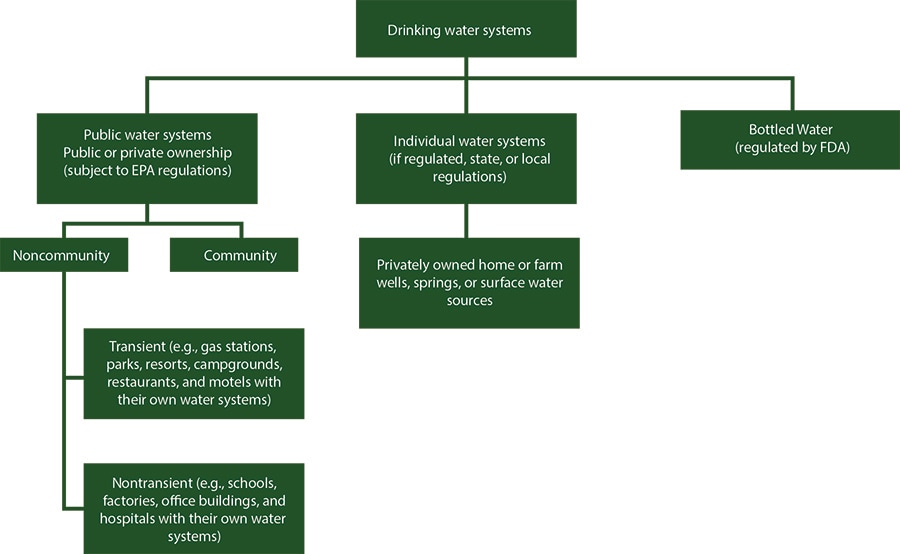History of Drinking Water Regulations
Drinking water regulations depend on the type of water system (Figure 1). The U.S. Environmental Protection Agency (EPA)external icon regulates public water systems, and the U.S. Food and Drug Administrationexternal icon regulates commercially bottled water. Individual water systems, such as private wells and cisterns, are not federally regulated. However, certain states and localities might set standards for these water supplies (for example, driller licensing and registration, well permitting, and water testing processes). Standards and requirements for private wells vary.

EPA Regulations
The Safe Drinking Water Act (SDWA) of 1974 and its subsequent 1986 and 1996 amendments authorize the EPA to set national standards to protect public drinking water and its sources against naturally occurring or human-made contaminants 1-3. SDWA standards include health-based maximum levels for microbiologic, chemical, and other contaminants in drinking water. They also include water treatment performance criteria for removing or inactivating contaminants (Table 1). If needed, EPA can issue guidance or a health advisory instead of a regulation.
Additional rules that protect against exposure to waterborne pathogens include the 1989 Surface Water Treatment Rule (SWTR) pdf icon[PDF – 57 pages]external icon and its amendments 1-9, and the 2013 Revised Total Coliform Rule.
The surface water treatment rule and amendments specify water-treatment techniques (for example, filtration and disinfection), monitoring, and performance criteria for systems that use surface water sources to protect against Giardia and Cryptosporidium contamination. EPA has granted waivers from the filtration requirement to some water systems. EPA has established criteria to assess whether ground water sources are under the direct influence of surface water. If so, these systems must meet provisions of the treatment rule and amendments.
Table 1. Selected EPA listings and regulations regarding drinking water, by year enacted — United States, 1974–2009
| Regulation | Year |
|---|---|
| Safe Drinking Water Act (SDWA) | 1974 |
| Interim Primary Drinking Water Standards | 1975 |
| National Primary Drinking Water Standards | 1985 |
| SDWA Amendments | 1986 |
| Surface Water Treatment Rule (SWTR) | 1989 |
| Total Coliform Rule (TCR) | 1989 |
| Chemical Contaminant Rules Phase I | 1989 |
| Lead and Copper Regulations | 1990 |
| Chemical Contaminant Rules Phase II | 1992 |
| Chemical Contaminant Rules Phase IIB | 1993 |
| Chemical Contaminant Rules Phase V | 1994 |
| SDWA Amendments | 1996 |
| Information Collection Rule | 1996 |
| Interim Enhanced SWTR | 1998 |
| Stage 1 – Disinfectants and Disinfection By-Products (D-DBP) Regulation | 1998 |
| Drinking Water Contaminant Candidate List | 1998 |
| Unregulated Contaminant Monitoring Regulations | 1999 |
| Radionuclides Rule | 2000 |
| Lead and Copper Rule — action levels | 2000 |
| Filter Backwash Recycling Rule | 2001 |
| Long Term 1 Enhanced SWTR | 2002 |
| Unregulated Contaminant Monitoring Regulations | 2002 |
| Drinking Water Contaminant Candidate List 2 | 2005 |
| Long Term 2 Enhanced SWTR | 2006 |
| Stage 2 D-DBP Rule | 2006 |
| Ground Water Rule | 2006 |
| Aircraft Drinking Water Rule (ADWR) | 2009 |
| Drinking Water Contaminant Candidate List 3 | 2009 |
| Revised Total Coliform Rule (RTCR) | 2013 |
- Water programs: national interim primary drinking water regulations, 1975. Fed Regist.. 59566-74.
- Pontius F, Roberson JA. The current regulatory agenda: an update. Major changes to USEPA’s current regulatory agenda are anticipated when the SDWA is reauthorized. J Am Water Works Assoc 1994;86(54ve):54-63.
- Pontius F. Implementing the 1996 SDWA amendments. J Am Water Works Assoc 1997;89:18-36.
- Drinking water, national primary drinking water regulations, filtration, disinfection, turbidity, Giardia lamblia, viruses, Legionella, and heterotrophic bacteria; final rule.pdf icon[PDF – 57 pages]external icon Fed Regist. 1989. 27486-541.
- National primary drinking water regulations: interim enhanced surface water treatment; final rule.pdf icon[PDF – 45 pages]external icon Fed Regist. 1998;63:69478-521.
- National primary drinking water regulations: long term 1 enhanced surface water treatment rule; final rule.external icon Fed Regist. 2002;67:1812-44.
- National primary drinking water regulations: long term 2 enhanced surface water treatment rule.external icon Fed Regist. 2006;71:653-702.
- National primary drinking water regulations: monitoring requirements for public drinking water supplies: Cryptosporidium, Giardia, viruses, disinfection byproducts, water treatment plant data and other information requirements; final rule. Fed Regist. 1996;61:24353-88.
- National primary drinking water regulations: stage 2 disinfectants and disinfection byproducts rule. Fed Regist. 2006;71:387-493.
- Drinking water; national primary drinking water regulations; total coliforms (including fecal coliforms and E. coli); final rule. Fed Regist. 1989;54:27544-68.
- Drinking water; national primary drinking water regulations; total coliforms; corrections and technical amendments; final rule. Fed Regist. 1990;55:25064-5.
- National primary drinking water regulations: ground water rule. Fed Regist. 2006;19:40 CFR Parts 9, 141, and 142:65573-660.
- Announcement of the drinking water contaminant candidate list; notice. Fed Regist. 1998;63:10274-87.
- Drinking water contaminant candidate list 3; final notice. Fed Regist. 2009;74:51850-62.
- Unregulated contaminant monitoring regulation for public water systems; amendment to the list 2 rule and partial delay of reporting of monitoring results. Fed Regist. 2001;66:46221-4.
- Unregulated contaminant monitoring regulation for public water systems; analytical method for list 2 contaminants; clarifications to the unregulated contaminant monitoring regulation. Fed Regist. 2001;66:2273-308.
- Unregulated contaminant monitoring regulation for public water systems; establishment of reporting date. Fed Regist. 2002;67:11043-6.
- Unregulated contaminant monitoring regulation: approval of analytical method for Aeromonas; national primary and secondary drinking water regulations: approval of analytical methods for chemical and microbiological contaminants. Fed Regist. 2002;67:65888-902.
- Drinking water contaminant candidate list 2; final notice. Fed Regist. 2005;70:9071-7.
- Basic information on CCL and regulatory determinations.external icon